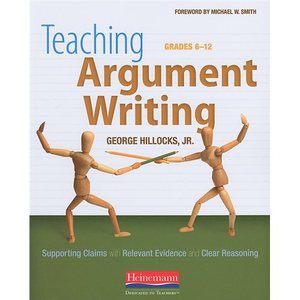Teaching Argument Writing
Teaching Argument Writing: Supporting Claims with Relevant Evidence and Clear Reasoning
by George Hillocks, Jr.
(Heinemann, 2011 – Learn more)
Let’s face it, nobody can argue like middle school students. They come to us armed with the ability to form an opinion and defend it. Whether or not their opinion or defense is rooted in sound evidence or critical thought is another issue entirely.
Faced with the Common Core challenge of developing quality opinion writers, Teaching Argument Writing Grades 6-12 helps the reader begin to clarify his/her own definition of quality argument writing and explore exemplar lessons that are rooted in meaningful academic discourse and critical thinking.
Hillocks subscribes to Stephen Toulmin’s conception of argument writing, found in The Uses of Argument, which includes the following elements:
A claim
- Based on evidence of some sort
- A warrant that explains how the evidence supports the claim
- Support for the warrant(s)
- Qualifications and rebuttals or counter arguments that refute competing claims.
After taking a closer look at each element, Hillocks moves the reader through high-interest lessons and transcripts of classroom discussions leading students to apply the Toulmin elements in developing their own arguments. Though Hillocks begins with an exemplar lesson that middle school teachers may find grisly (solving a murder mystery based on forensic evidence in the drawing provided), there is no doubt that Hillocks has a knack for finding content that will engage middle grades students in spirited discussion (choosing a school mascot, defining heroism, etc.)
Through exploration of these lessons in action, Hillocks leads the reader through scenarios moving from simple arguments of fact to more complex arguments of judgment and policy.
Common Core Implications
Perhaps most relevant to those preparing for Common Core implementation is the last chapter, “Argument and Interpretation: Teaching Students How to Make Literary Judgments.” In this chapter, Hillocks notes evidence from the National Assessment of Educational Progress (NAEP) which shows that while American students can read text at a literal level fairly well, when it comes to making inference, they “fail miserably.”
In the exemplar lesson that Hillocks shares, the teacher uses text to teach students to think interpretively about literature. This leads to what I found to be the “juiciest morsel” of the book, a brief section on the systematic planning of instructional units. Hillocks shows teachers the step-by-step planning process for development of an inquiry-based argument unit rooted in text evidence.
Long on Discourse, Short on Assessment
Each exemplar argument lesson focuses heavily on students developing an understanding of the overarching concept and arriving at common definitions of important terms. While the development of common understanding and construction of common background knowledge is no doubt important, I found myself wading through lengthy transcripts of student comments and discussions and longing for more information about the writing assignments themselves and more examination of student work. I was expecting a more practical guide that might include rubrics, checklists for argument writing, or an appendix of usable classroom resources based on the exemplar lessons within.
More Theory Than Practice
Though not the practical, portable “take immediately to the copy machine” guide I was expecting, the book did help me begin to wrap my brain around what quality argument in the classroom sounds and looks like. It does a good job illustrating what students whose opinions are rooted in founded claims sound like and how they begin to formulate thoughts that will inform effective argument writing.
This book will get you thinking! And that’s a good place to start for teachers who have previously focused on expository writing or the old notion of persuasive writing.
Jaime Greene is the Middle School and High School Instructional Coach for Hamblen County Schools in Morristown, Tennessee. She has delivered professional development regionally on topics including instructional strategies, constructed response, middle school writing, and student motivation.





































